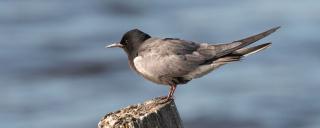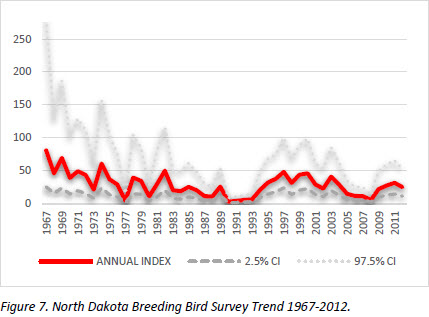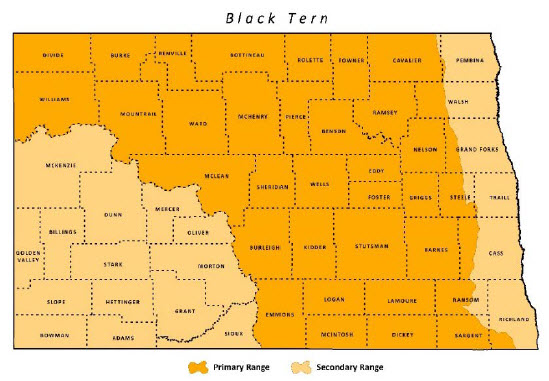
Black Tern
| Scientific Name | Chlidonias niger |
|---|---|
| General Description | L 9.75”, WS 24”, 2.2 oz. Nearly all black except for gray wings and white undertail. |
| Status | Occurs in North Dakota from May to mid-September. Peak breeding season early June to mid-July. |
| Abundance | Common to abundant. |
| Primary Habitat | Shallow wetlands surrounded by grassland. |
| Federal Status | Migratory Bird. |
| Reason for Designation | Black Terns are designated as High Concern in the Northern Prairie and Parkland Waterbird Conservation Plan (NPPWCP) and Moderate Concern by Waterbird Conservation for the Americas. Fifty percent of the population breeds in BCR11. |
Locations and Conditions of Key Habitat
Preferred Habitat
Black Terns use wetland complexes of shallow wetlands, typically greater than 20 ha, with an equal amount of open water and emergent vegetation. Sometimes brackish or alkaline, semi-permanent, marshes and wetlands, lake margins, edges of islands or slow-moving rivers, wet meadows, restored wetlands, and occasionally stock ponds are used. Stable water levels throughout breeding season and abundant nest substrate is important. Large areas of open water used for foraging. Prefers wetlands surrounded by grassland rather than agricultural fields. Nests singly or semicolonially on a floating mat of residual vegetation in sparse to moderately dense emergent vegetation. The nest is 2-20 cm above water that is 0.05-1.2 meters deep. Or, will occasionally nest on abandoned muskrat houses, deserted nests of other wetland birds, mudflats, sandbars, or artificial platforms. Forage for insects over both land and water. Small fish are also consumed.
Key Areas and Conditions for black tern in North Dakota
No specific sites have been identified. Common throughout the Drift Prairie and Missouri Coteau but the presence of this species is highly dependent upon water availability. Wetland complexes are important.
Problems Which May Affect this Species
Habitat
Destruction and/or degradation of wetlands is the greatest threat to Black Terns in North Dakota. Woody vegetation around wetlands negatively affects tern presence.
Other Natural or Manmade Factors
This species is highly insectivorous and pesticides or contaminants may be an issue. Terns may be tolerant of human activity near nesting colonies, as long as colony is not entered. Mortality from collisions with power lines. Expanding oil and gas development in North Dakota increases risk of oilfield contamination of wetland habitat.
Research and Survey Efforts
Current Research or Surveys
- Rocky Mountain Bird Observatory (ND SWG T-40-R) is conducting a statewide inventory of colonial and semi-colonial waterbird populations and identifying key sites for breeding colonies in North Dakota. The Black Tern is one of 29 target species. The project was initiated in March 2014.
Previous Research or Surveys
- Northern Prairie Wildlife Research Center (ND SWG T-3-1 and T- 9-R) determined marsh bird distribution in relation to landscape composition in North Dakota. The project was initiated in 2004 and a final report provided in 2008. Black Terns were one of 16 focal species. Terns were 11.0 times more likely to occur at wetlands in the Drift Prairie and 7.6 more likely to occur at wetlands in the Missouri Coteau, than the Red River Valley. The probability that they would occur at a wetland were positively correlated with the percent of wetlands in the landscape and 2.7 more likely to occur on un-manipulated wetlands (Sherfy and Anteau 2008).
- Fair number of published reports and gray literature throughout the species range and in North Dakota.
Additional Research or Surveys Needed
- Determine habitat selection and the role of wetland complexes.
- Determine effective ways to control encroachment of cattails.
- Determine site fidelity and how it is influenced by water conditions.
- Determine the effects of contaminants or insecticides on wetland quality and prey species.
Population and Trend Estimates

- North American Waterbird Conservation Plan Population Estimate: 100,000 – 500,000 breeders
- NPPWCP BCR11 Population Estimate: unknown
- North Dakota BBS Trend: see figure 7
- Survey-wide BBS Trend 1966-2012: -2.39
Management Recommendations
- Maintain wetland complexes.
- Provide wetland complexes with equal proportions of interspersed emergent vegetation and open water.
- Prevent encroachment of woody vegetation around wetlands.
- Conduct management to open cattail-choked wetlands.
- Utility development should follow the guidance of “Reducing Avian Collisions with Power Lines” including marking power lines and creating an Avian Protection Plan.
Monitoring Plans
The NPPWCP has identified the basic elements of how a regional/continental waterbird monitoring program should be structured. Waterbird monitoring should follow recommendations of the Waterbird Conservation for the Americas and North American Bird Conservation Initiative ‘Opportunities for Improving Avian Monitoring’.
2005-2015 Progress
The Black Tern remains a Level I Species of Conservation Priority. Efforts to identify key sites for breeding areas are underway. Several State Wildlife Grant Projects (T2-9-R, T-18-R, T-27-HM,) have contributed to habitat enhancement of wetlands for Black Tern and other wetland dependent birds.

Note: A listing of works consulted when compiling the information on this page may be found in the 2015 State Wildlife Action Plan.
